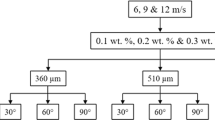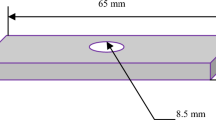Abstract
The cracking behavior of oxides on 304 stainless steel plate surfaces under slurry impact has been investigated for the problem of the lack of an accurate model for the removal of oxide scale in slurry impact descaling. A backpropagation (BP) neural network model was established using experimental data of oxide removal by shotcrete. The results show that: (1) the ratio of the impact of the spray pressure and spray distance on the removal of oxide scale on the substrate surface is 3.186:2.726; (2) the maximum deviation rate between the predicted values of injection pressure and injection distance and the sample values is 8.53%; and (3) the descaling process parameters provided by the BP neural network model were used in the experiment, and the maximum deviation rate between the scale removal amount and the target value was 7.14%. This study provides guidance for the promotion and application of impact descaling technology.






Similar content being viewed by others
References
X. Fang, M. Duan, X. Yang, and S. Li, Baosteel Technol. 2019(1), 7 (2019).
X. Liu, Study on the Influence of Abrasive Slurry Jet Process Parameters on the Surface Morphology of Metal Sheets (Taiyuan University of Science and Technology, Shanxi, 2019).
R. Guo, C. Zhou, J. Duan, M. Fan, and J. Gong, J. Plast. Eng. 30(3), 183 (2023).
W. Wu, Y. Tang, S. Yuan, W. Li, Q. Tan, and B. Liu, Mod. Manuf. Eng. 10, 101 (2022).
M. Schutze, P.F. Tortorelli, and I.G. Wright, Oxid. Met. 73, 389 (2010).
O.P. Modi, D.P. Mondal, B.K. Prasad, M. Singh, and H.K. Khaira, Mater. Sci. Eng. A 343(1), 235 (2003).
H. Hamdi, M. Dursaot, and H. Zahouani, Wear 254(12), 1294 (2003).
N. Wang, J. Li, and S. Zhang, Gansu Metall. 38(3), 28 (2016).
H.R. Le, M.P.F. Sutcliffe, P.Z. Wang, and G.T. Burstein, Acta Mater. 52(4), 911 (2004).
X. Sun, S. Fang, and L. Guan, Mechanics of Materials, 4th edn. (Higher Education Press, Bei**g, 2002).
W. Yang, Micro Macro Fracture Mechanics (National Defense Industry Press, Bei**g, 1995).
S. Lee, S.R. Kim, R.E. Triambulo, C.J. Lim, H.J. Kim, J.Y. Suh, H.G. Kang, and J.W. Park, ACS Omega 7, 15174 (2022).
W.A.N.G. Shang, Simulation and Experimental Study on Shot Blast Impact Process for Acid Free Descaling of Rolled Strip Steel (Bei**g University of Science and Technolog, Bei**g, 2018).
L. Ge, J. Harbin Inst. Technol. 37(7), 986 (2005).
G. Cybenko, Math. Control Signals Syst. 2(4), 303 (1989).
K.I. Funahashi, Neural Netw. 2(3), 183 (1989).
K. Hornik, Neural Netw. 4(2), 251 (1991).
Statistics Group of Institute of Mathematics, Chinese Academy of Sciences. Variance Analysis (Science Press, Bei**g, 1977).
Q. Iu, K. Wang, X. Li, J. Wang, K. Zhang, and X. Gao, J. Plast. Eng. 28(11), 167 (2021).
H. Hao and R. Jiang, J. Autom. 33(12), 1247 (2007).
Acknowledgements
Funds: Central guidance for local scientific and technological development funds (Z135050009017); Key R&D Plan of Shanxi Province (201903D421046); Shanxi Province Graduate Education Innovation Project (BY2022010); Shanxi Province Higher Education Science and Technology Innovation Plan Project (2022L308)
Author information
Authors and Affiliations
Contributions
All the authors contributed equally to this work.
Corresponding author
Ethics declarations
Conflict of interest
The authors declare that they have no conflict of interest.
Additional information
Publisher's Note
Springer Nature remains neutral with regard to jurisdictional claims in published maps and institutional affiliations.
Rights and permissions
Springer Nature or its licensor (e.g. a society or other partner) holds exclusive rights to this article under a publishing agreement with the author(s) or other rightsholder(s); author self-archiving of the accepted manuscript version of this article is solely governed by the terms of such publishing agreement and applicable law.
About this article
Cite this article
Chai, Zl., Zhou, Cl., Guo, R. et al. Research on the Model of Scale Removal under Slurry Impact Based on BP Neural Network. JOM 76, 445–451 (2024). https://doi.org/10.1007/s11837-023-06206-6
Received:
Accepted:
Published:
Issue Date:
DOI: https://doi.org/10.1007/s11837-023-06206-6




